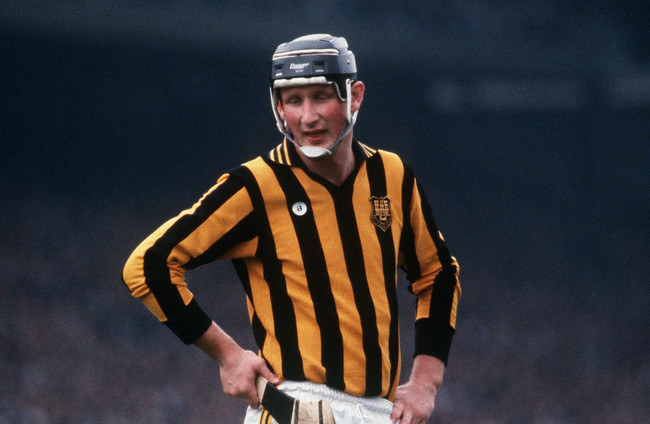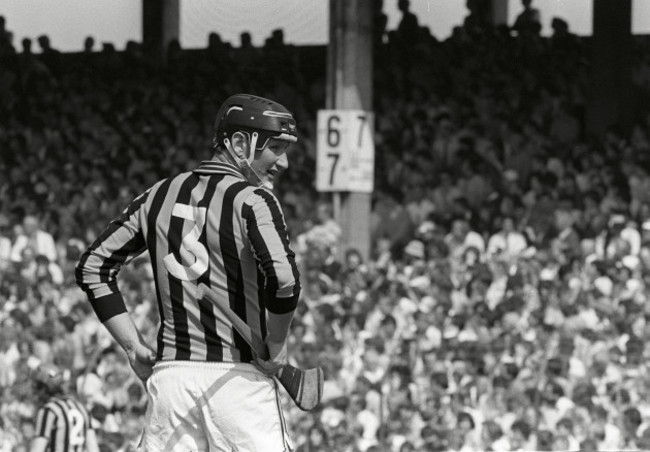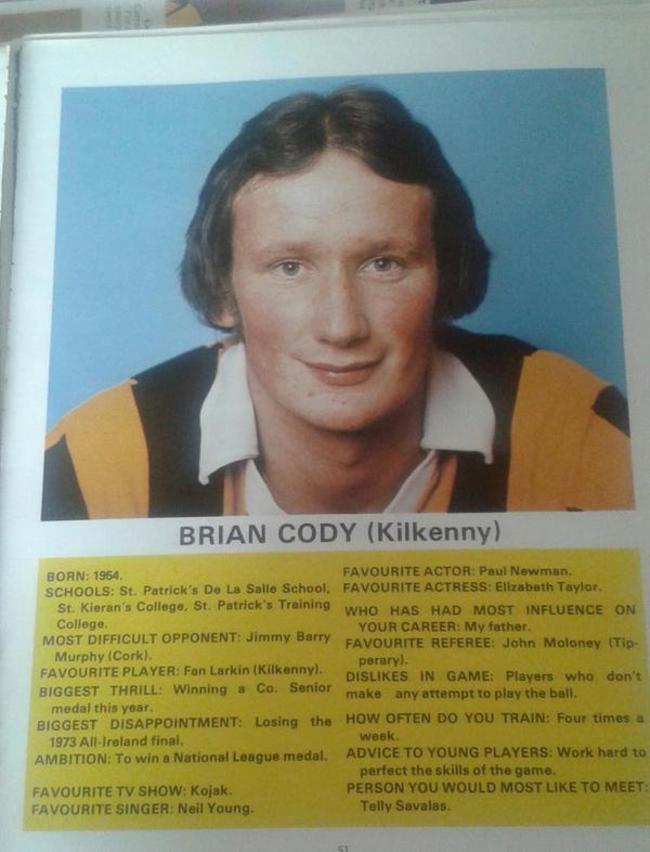NICKEY BRENNAN WAS booked just twice in his hurling life. The former GAA president was once shown a yellow card in an All-Ireland colleges decider. The other came in a Kilkenny Interfirm county final, Avonmore versus Kilkenny teachers. That was as a result of hitting out at an unabating defender by the name of Brian Cody.
“I was a much better player than I’m a manager,” Cody told RTÉ’s documentary series The Game.
“I almost forgot myself I had the privilege of playing the game for a long time as well. If I could have stayed hurling, stayed playing the game, that is what I would have done. All hurlers are the same. If you could play forever, you would.”
Before he donned the cap and spent the next 23 years patrolling the sideline, the Kilkenny boss was a decorated and celebrated player. His excellence then explains his equilibrium now.
During a glittering career, Cody won four senior All-Irelands and was captain of the winning team in 1982. He also won three National Leagues – in 1976, ’82 and ’83. He captained the Kilkenny All-Ireland minor team of 1972 and he won another at U21. Always fuelled by an internal fire, powering him to delve deeper and do more. It rages still.
“Brian was a class hurler. A really class hurler,” says James Stephens’ man Jimmy O’Brien. He was captain in 1982 when the club won the All-Ireland club title.
“He had weak ankles and suffered injuries later. That hampered him but as a hurler he was class. His whole approach to it, he was very driven. That is the way he approached all games. Everything hurling.”
Cody came through the St Kieran’s College production line, where he discovered the basic canons of Kilkenny hurling. All part of a rigorous pre-deployment training camp that would see him become the highest power in the county. In 1971 he captained the school to a Leinster and All-Ireland medal.
His father Bill, who he frequently hails as his biggest influence, had been instrumental in forming a juvenile section within the James Stephens club while later serving as a selector for Kilkenny minors and seniors. An established template.
He went on to attend St Pat’s teacher training college in Drumcondra. There he encountered a like-minded devotee. Ger Loughnane was a year ahead of him. The two high kings of modern hurling were housed in the same building and pucked around regularly. They had contests to land the most 70s or penalty shoot-outs.
In terms of hurling knowledge, it was no contest. Cody was a scholar. He could list starting teams and results of All-Ireland finals stretching back decades.
But they shared the same demanding value system. Cody continued to mine the same source for the next 50 years; employing it as the foundation upon which he would build an empire.
“God-given, it is a talent. We all have various talents,” Cody later said in an interview reflecting on his life. “You need to nurture it, but once you develop it and work at it, you find out how good you can be at it. I wanted to find out how good I could be at hurling and wanted to be as good as I possibly could be.”
He was listed as 6’1 and a half in match reports, weighing in at 14 stone. Most of his answers to the programme questions changed as the years went by. In 1976 his favourite actor was Paul Newman and toughest opponent Jimmy-Barry Murphy. In 1982 it was Dustin Hoffman and Tony Doran.
Yet his advice to younger players never wavered: ‘Work hard to perfect the skills of the game.’
When renowned coach Fr Tommy Maher was tasked to help make an RTE production ‘Skills of Hurling’, he requested Cody teach the skill of catching the ball.
“It is important to catch it with your fingers and not in the palm of your hand,” the fresh-faced 22-year-old stressed. Even then a man who prioritised perfecting the basics.
Too simple? Perhaps. Then again, a few years ago when Tipperary coaching great and former National Hurling Director Paudie Butler sent two Antrim men to attend Kilkenny training before an All-Ireland final to film it and report back with their findings, they arrived at the Central Council meeting and announced they had a problem. There was nothing to report. Cody’s team did nothing unusual.
Loughnane and Cody backboned the St Pat’s team that stormed through the Advanced Colleges S.H.L. When they beat Queens University by 28 points, they hit 0-1 and 0-2 respectively of a 10-13 total. But it was Cody who earned rave reviews in match reports at the time.
Then a minor star, his defensive dominance was remarkable. At half-time in Drumcondra, they had scored 5-12. Meanwhile the rear-guard he commanded conceded just a single goal.
There was so much hurling in him that he could play anywhere. He was centre-back for their 17-point minor county final victory over Ballyhale. He broke into the seniors as a wing-back and went on to full-back. In the 1978 final against Cork, he lined out at full-forward. Phil ‘Fan’ Larkin at one end, Cody at the other. Titans either side.
James Stephens thrived in the 1980s, winning a club All-Ireland in 1982. It was their second in six years during a golden era for the club, with the likes of Larkin, Billy Walton, Andy Egan, Cody, Denis and Tom McCormack all excelling.
For the first time ever, they started out that campaign training indoors. Mick O’Flynn, a seven-time Irish triple jump champion, was a teacher who used his school hall and devised a punishing fitness plan. By the time they played Fenians in the county final, the underdogs were rearing to go.
“Most people want to see country teams winning,” explains O’Brien. “That is the way it is. We were seen as city boys really. In saying that, the great thing Kilkenny have is that despite strong rivalries when it comes to county, lads pull together.
“There was a belief at one stage no Village man would ever captain an All-Ireland winning team. That was there up until the time Brian captained Kilkenny. He was the first. We had a few since. The belief started there.”
In 1982 Kilkenny beat Cork in the All-Ireland final. At one point in the first half, their full-back and captain won a ball out in front, threw it up on his Star hurley and took off under the Hogan Stand. Cody soloed along the wing, bounced the ball off the ground and kept going, before delivering an accurate short stick pass to the inside line.
It was a piece of skill that wouldn’t look out of place today.
At the same time as he was winning back-to-back All-Irelands, Cody was coaching. He took a local U12s team alongside fellow senior Matt Ruth. As injury began to curtail his playing career, he invested even more in the rest of the game.
There was the occasional kick. In 1986, the Kilkenny People noted with some surprise that Kilkenny persisted with their victorious national league team for the opening championship clash with Wexford.
“While the team, or the 14 named, was along expected lines, the mentors threw their net wide and hauled in another big fish. Former county full-back Brian Cody has been listed among the reserves.”
It came off the back of an impressive showing in the O’Byrne Cup against Glenmore.
O’Brien has watched closely as Cody has gone on to enjoy extraordinary success as a manager. Is he surprised the Cats’ boss has been able to endure in a rapidly evolving game?
“I know for a fact Brian would be a very keen observer of up-and-coming hurlers throughout the county. Club, college, second level. He is watching everything. He knows what is coming.
“Also, in one sense, you still have to have basics. Win your ball. Fight for your ball. Use it intelligently. The game hasn’t changed in that way. If you don’t have the skills you are at nothing.
“What has changed is what comes with it. How teams prepare now compared to the 1980s. Strength and conditioning, fitness, nutrition, players use shorter hurls because of less ground hurling, even the ball. It will travel distances the old one couldn’t.
“I was reading a book there before I rang you. Hell for Leather: A Journey Through Hurling in 100 Games. They have a chapter about how hurling changes and the debate stays the same.
“There was a comment in it by a journalist, P.D Mehigan. He made it after the 1934 All-Ireland final. He said, ‘are we following sound lines in careering for speed and dainty ball play as contrasted with the dare-devil pluck of sweeping, dashing fearless men of might and brawn which took our hearts and breaths away in those brave days when our association was young?’
“You hear similar stuff now. Anyway, games evolve and change. What we have now, people take about raised a level, as if it is a better game now. It is different but better? I don’t know.”
A final note. In 1983 Kilkenny and Cody completed back-to-back All-Irelands. At the start of that year, the now-defunct Monthly magazine ‘Gaelic Sport’ previewed the upcoming campaign. It was noted the difficulty in backing up Liam MacCarthy success, but they did add one word of caution.
“None will dare to suggest Brian Cody is a spent force. The Kilkenny stalwart has long since proved resilience is one of his greatest assets.”
Indeed.





